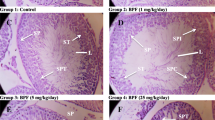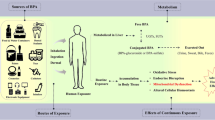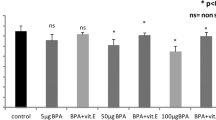Abstract
Polycarbonate plastics for packaging and epoxy resins are both made with the industrial chemical bisphenol A (BPA). This investigation looked at the histological structure, antioxidant enzymes, and albino rats’ testis to determine how coenzyme Q10 (CoQ10) impacts BPA toxicity. For the experiments, three sets of 18 male adult rats were created: group 1 received no therapy, group 2 acquired BPA, and group 3 got the daily BPA treatment accompanied by coenzyme Q10, 1 h apart. The experimental period ran for 14 days. The biochemical biomarkers catalase (CAT), superoxide dismutase (SOD), and malondialdehyde (MDA) were altered as a result of BPA exposure. The testicular histological architecture, which is made up of apoptosis, was also exaggerated. Furthermore, rats given BPA and CoQ10 treatment may experience a diminution in these negative BPA effects. These protective properties of CoQ10 may be correlated with the ability to eliminate oxidizing substances that can harm living species. The outcomes might support the hypothesis that CoQ10 prevented oxidative damage and boosted rats’ stress responses when BPA was introduced. Thus, by shielding mammals from oxidative stress, CoQ10 aids in the growth and development of the animals. BPA is extremely hazardous to humans and can persist in tissues. Human reproductive functions are a worry due to human exposure to BPA, especially for occupational workers who are typically exposed to higher doses of BPA. As a result, in order to reduce the health risks, BPA usage must be minimized across a diverse range of industries, and improper plastic container handling must be prohibited. By giving CoQ10 to patients, BPA’s harmful effects on reproductive structures and functions may be avoided.







Similar content being viewed by others
Data availability
Data presented in this study are available upon reasonable request from the corresponding author.
References
Abu-Abed U, Brinkmann V (2020) Immunofluorescent detection of NET components in paraffin-embedded tissue. Methods Mol Biol (Clifton N.J.) 2087:415–424
Agarwal A, Mulgund A, Hamada A, Chyatte MR (2015) A unique view on male infertility around the globe. Reprod Biol Endocrinol : RB&E 13:37
Aitken RJ, Roman SD (2008) Antioxidant systems and oxidative stress in the testes. Oxid Med Cell Longev 1:15–24
Akingbemi BT, Sottas CM, Koulova AI, Klinefelter GR, Hardy MP (2004) Inhibition of testicular steroidogenesis by the xenoestrogen bisphenol A is associated with reduced pituitary luteinizing hormone secretion and decreased steroidogenic enzyme gene expression in rat Leydig cells. Endocrinology 145:592–603
Alshehri AS, El-Kott AF, El-Kenawy AE, Khalifa HS, AlRamlawy AM (2021) Cadmium chloride induces non-alcoholic fatty liver disease in rats by stimulating miR-34a/SIRT1/FXR/p53 axis. Sci Total Environ 784:147182
Anjum S, Rahman S, Kaur M, Ahmad F, Rashid H, Ansari RA, Raisuddin S (2011) Melatonin ameliorates bisphenol A-induced biochemical toxicity in testicular mitochondria of mouse. Food Chem Toxicol: Int J Publ British Ind Biol Res Ass 49:2849–2854
Arany I, Carter A, Hall S, Fulop T, Dixit M (2017) Coenzyme Q10 protects renal proximal tubule cells against nicotine-induced apoptosis through induction of p66(shc)-dependent antioxidant responses. Apoptosis: an Int J Programmed Cell Death 22:220–228
Belloc S, Hazout A, Zini A, Merviel P, Cabry R, Chahine H, Copin H, Benkhalifa M (2014) How to overcome male infertility after 40: influence of paternal age on fertility. Maturitas 78:22–29
Ben-Meir A, Burstein E, Borrego-Alvarez A, Chong J, Wong E, Yavorska T, Naranian T, Chi M, Wang Y, Bentov Y, Alexis J, Meriano J, Sung HK, Gasser DL, Moley KH, Hekimi S, Casper RF, Jurisicova A (2015) Coenzyme Q10 restores oocyte mitochondrial function and fertility during reproductive aging. Aging Cell 14:887–895
Bentov Y, Hannam T, Jurisicova A, Esfandiari N, Casper RF (2014) Coenzyme Q10 supplementation and oocyte aneuploidy in women undergoing IVF-ICSI treatment. Clin Med Insights Rep Health 8:31–36
Bilal M, Iqbal HMN, Barceló D (2019) Mitigation of bisphenol A using an array of laccase-based robust bio-catalytic cues — a review. Sci Total Environ 689:160–177
Bindhumol V, Chitra KC, Mathur PP (2003) Bisphenol A induces reactive oxygen species generation in the liver of male rats. Toxicology 188:117–124
Bin-Meferij MM, El-Kott AF (2015) The radioprotective effects of Moringa oleifera against mobile phone electromagnetic radiation-induced infertility in rats. Int J Clin Exp Med 8:12487–12497
Blanco-Rodríguez J, Martínez-García C (1998) Apoptosis precedes detachment of germ cells from the seminiferous epithelium after hormone suppression by short-term oestradiol treatment of rats. Int J Androl 21:109–115
Bosch RJ, Quiroga B, Muñoz-Moreno C, Olea-Herrero N, Arenas MI, González-Santander M, Reventún P, Zaragoza C, de Arriba G, Saura M (2016) Bisphenol A: an environmental factor implicated in renal vascular damage. Nefrol Publ Oficial de la Sociedad Espanola Nefrologia 36:5–9
Cariati F, D’Uonno N, Borrillo F, Iervolino S, Galdiero G, Tomaiuolo R (2019) Bisphenol A: an emerging threat to male fertility. Reprodu Biol Endocrinol: RB&E 17:6
Chang WH, Liu SC, Chen HL, Lee CC (2019) Dietary intake of 4-nonylphenol and bisphenol A in Taiwanese population: integrated risk assessment based on probabilistic and sensitive approach. Environmental pollution (Barking, Essex : 1987) 244, 143–152
Chen HH, Yeh TC, Cheng PW, Ho WY, Ho CY, Lai CC, Sun GC, Tseng CJ (2019) Antihypertensive potential of coenzyme Q10 via free radical scavenging and enhanced Akt-nNOS signaling in the nucleus tractus solitarii in rats. Mol Nutr Food Res 63:e1801042
Chianese R, Viggiano A, Urbanek K, Cappetta D, Troisi J, Scafuro M, Guida M, Esposito G, Ciuffreda LP, Rossi F, Berrino L, Fasano S, Pierantoni R, De Angelis A, Meccariello R (2018) Chronic exposure to low dose of bisphenol A impacts on the first round of spermatogenesis via SIRT1 modulation. Sci Rep 8:2961
Chitra KC, Latchoumycandane C, Mathur PP (2003) Induction of oxidative stress by bisphenol A in the epididymal sperm of rats. Toxicology 185:119–127
D’Cruz SC, Jubendradass R, Mathur PP (2012) Bisphenol A induces oxidative stress and decreases levels of insulin receptor substrate 2 and glucose transporter 8 in rat testis. Reproductive sciences (Thousand Oaks, Calif.) 19: 163–72
Das M, Al-Hathal N, San-Gabriel M, Phillips S, Kadoch IJ, Bissonnette F, Holzer H, Zini A (2013) High prevalence of isolated sperm DNA damage in infertile men with advanced paternal age. J Assist Reprod Genet 30:843–848
Eid RA, Khalil MA, Alkhateeb MA, Eleawa SM, Zaki MSA, El-Kott AF, Al-Shraim M, El-Sayed F, Eldeen MA, Bin-Meferij MM, Awaji KME, Shatoor AS (2021) Exendin-4 attenuates remodeling in the remote myocardium of rats after an acute myocardial infarction by activating β-arrestin-2, protein phosphatase 2A, and glycogen synthase kinase-3 and inhibiting β-catenin. Cardiovasc Drugs Ther 35:1095–1110
Eisenberg ML, Meldrum D (2017) Effects of age on fertility and sexual function. Fertil Steril 107:301–304
Fouad AA, Al-Sultan AI, Yacoubi MT (2011) Coenzyme Q10 counteracts testicular injury induced by sodium arsenite in rats. Eur J Pharmacol 655:91–98
Gassman NR (2017) Induction of oxidative stress by bisphenol A and its pleiotropic effects. Environ Mol Mutagen 58:60–71
Gat I, Blanco Mejia S, Balakier H, Librach CL, Claessens A, Ryan EA (2016) The use of coenzyme Q10 and DHEA during IUI and IVF cycles in patients with decreased ovarian reserve. Gynecol Endocrinol : Off J Int Soc Gynecol Endocrinol 32:534–537
Grewal AK, Singh TG, Sharma D, Sharma V, Singh M, Rahman MH, Najda A, Walasek-Janusz M, Kamel M, Albadrani GM, Akhtar MF, Saleem A, Abdel-Daim MM (2021) Mechanistic insights and perspectives involved in neuroprotective action of quercetin. Biomed Pharmacother Biomed Pharmacother 140:111729
Gurmeet K, Rosnah I, Normadiah MK, Das S, Mustafa AM (2014) Detrimental effects of bisphenol A on development and functions of the male reproductive system in experimental rats. EXCLI J 13:151–160
Iqbal N, Zubair HM, Almutairi MH, Abbas M, Akhtar MF, Aleya L, Kamel M, Saleem A, Jabeen Q, Noreen S, Baig M, Abdel-Daim MM (2022) Hepatoprotective effect of Cordia rothii extract against CCl(4)-induced oxidative stress via Nrf2-NFκB pathways. Biomed Pharmacother Biomed Pharmacother 156:113840
Kabuto H, Amakawa M, Shishibori T (2004) Exposure to bisphenol A during embryonic/fetal life and infancy increases oxidative injury and causes underdevelopment of the brain and testis in mice. Life Sci 74:2931–2940
Khalaf AA, Ahmed W, Moselhy WA, Abdel-Halim BR, Ibrahim MA (2019) Protective effects of selenium and nano-selenium on bisphenol-induced reproductive toxicity in male rats. Hum Exp Toxicol 38:398–408
Khalaf EM, Hassan HM, El-Baz AM, Shata A, Khodir AE, Yousef ME, Elgharabawy RM, Nouh NA, Saleh S, Bin-Meferij MM, El-Kott AF, El-Sokkary MMA, Eissa H (2022) A novel therapeutic combination of dapagliflozin, Lactobacillus and crocin attenuates diabetic cardiomyopathy in rats: Role of oxidative stress, gut microbiota, and PPARγ activation. Eur J Pharmacol 931:175172
Kurutas EB (2016) The importance of antioxidants which play the role in cellular response against oxidative/nitrosative stress: current state. Nutr J 15:71
Lamia SS, Emran T, Rikta JK, Chowdhury NI, Sarker M, Jain P, Islam T, Gias ZT, Shill MC, Reza HM (2021) Coenzyme Q10 and silymarin reduce CCl(4)-induced oxidative stress and liver and kidney injury in ovariectomized rats—implications for protective therapy in chronic liver and kidney diseases. Pathophysiology: Off J Int Soc Pathophysiol 28:50–63
Li YJ, Song TB, Cai YY, Zhou JS, Song X, Zhao X, Wu XL (2009) Bisphenol A exposure induces apoptosis and upregulation of Fas/FasL and caspase-3 expression in the testes of mice. Toxicological Sciences : an Off J Soc Toxicol 108:427–436
Liu XL, Chen XY, Wang ZC, Shen T, Zhao H (2013) Effects of exposure to bisphenol A during pregnancy and lactation on the testicular morphology and caspase-3 protein expression of ICR pups. Biomedical Reports 1:420–424
Ma S, Li R, Gong X, Shi W, Zhong X (2018) Lycopene reduces in utero bisphenol A exposure-induced mortality, benefits hormones, and development of reproductive organs in offspring mice. Environ Sci Pollut Res Int 25:24041–24051
Mínguez-Alarcón L, Bellavia A, Gaskins AJ, Chavarro JE, Ford JB, Souter I, Calafat AM, Hauser R, Williams PL (2021) Paternal mixtures of urinary concentrations of phthalate metabolites, bisphenol A and parabens in relation to pregnancy outcomes among couples attending a fertility center. Environ Int 146:106171
Mohammed ET, Hashem KS, Ahmed AE, Aly MT, Aleya L, Abdel-Daim MM (2020) Ginger extract ameliorates bisphenol A (BPA)-induced disruption in thyroid hormones synthesis and metabolism: involvement of Nrf-2/HO-1 pathway. Sci Total Environ 703:134664
Obata T, Kubota S (2000) Formation of hydroxy radicals by environmental estrogen-like chemicals in rat striatum. Neurosci Lett 296:41–44
Ohkawa H, Ohishi N, Yagi K (1979) Assay for lipid peroxides in animal tissues by thiobarbituric acid reaction. Anal Biochem 95:351–358
Pala R, Orhan C, Tuzcu M, Sahin N, Ali S, Cinar V, Atalay M, Sahin K (2016) Coenzyme Q10 supplementation modulates NFκB and Nrf2 pathways in exercise training. J Sports Sci Med 15:196–203
Rezvanfar MA, Rezvanfar MA, Shahverdi AR, Ahmadi A, Baeeri M, Mohammadirad A, Abdollahi M (2013) Protection of cisplatin-induced spermatotoxicity, DNA damage and chromatin abnormality by selenium nano-particles. Toxicol Appl Pharmacol 266:356–365
Rong Y, Gao J, Kuang T, Chen J, Li JA, Huang Y, Xin H, Fang Y, Han X, Sun LQ, Deng YZ, Li Z, Lou W (2021) DIAPH3 promotes pancreatic cancer progression by activating selenoprotein TrxR1-mediated antioxidant effects. J Cell Mol Med 25:2163–2175
Rosiak-Gill A, Gill K, Jakubik J, Fraczek M, Patorski L, Gaczarzewicz D, Kurzawa R, Kurpisz M, Piasecka M (2019) Age-related changes in human sperm DNA integrity. Aging 11:5399–5411
Sakuma S, Nakanishi M, Morinaga K, Fujitake M, Wada S, Fujimoto Y (2010) Bisphenol A 3,4-quinone induces the conversion of xanthine dehydrogenase into oxidase in vitro. Food Chem Toxicol: Int J Publ Brit Indust Biol Res Assoc 48:2217–2222
Saleh AAS, Shahin MI, Kelada NA (2017) Hepatoprotective effect of taurine and coenzyme Q10 and their combination against acrylamide-induced oxidative stress in rats. Trop J Pharm Res 16:1849–1855
Shati AA, El-Kott AF (2021) Acylated ghrelin protects against doxorubicin-induced nephropathy by activating silent information regulator 1. Basic Clin Pharmacol Toxicol 128:805–821
Siracusa JS, Yin L, Measel E, Liang S, Yu X (2018) Effects of bisphenol A and its analogs on reproductive health: a mini review. Reproductive Toxicology (Elmsford, N.Y.) 79:96–123
Sohet FM, Neyrinck AM, Pachikian BD, de Backer FC, Bindels LB, Niklowitz P, Menke T, Cani PD, Delzenne NM (2009) Coenzyme Q10 supplementation lowers hepatic oxidative stress and inflammation associated with diet-induced obesity in mice. Biochem Pharmacol 78:1391–1400
Takahashi O, Oishi S (2003) Testicular toxicity of dietarily or parenterally administered bisphenol A in rats and mice. Food and Chemical Toxicology : Int J Publ British Ind Biol Res Ass 41:1035–1044
Tekin S, Seven E (2022) Assessment of serum catalase, reduced glutathione, and superoxide dismutase activities and malondialdehyde levels in keratoconus patients. Eye (lond) 36:2062–2066
Tiwari D, Vanage G (2017) Bisphenol A induces oxidative stress in bone marrow cells, lymphocytes, and reproductive organs of Holtzman rats. Int J Toxicol 36:142–152
Tsuneki H, Sekizaki N, Suzuki T, Kobayashi S, Wada T, Okamoto T, Kimura I, Sasaoka T (2007) Coenzyme Q10 prevents high glucose-induced oxidative stress in human umbilical vein endothelial cells. Eur J Pharmacol 566:1–10
Ullah A, Pirzada M, Jahan S, Ullah H, Khan MJ (2019) Bisphenol A analogues bisphenol B, bisphenol F, and bisphenol S induce oxidative stress, disrupt daily sperm production, and damage DNA in rat spermatozoa: a comparative in vitro and in vivo study. Toxicol Ind Health 35:294–303
Vandenberg LN, Hunt PA, Gore AC (2019) Endocrine disruptors and the future of toxicology testing - lessons from CLARITY-BPA. Nat Rev Endocrinol 15:366–374
Wang P, Luo C, Li Q, Chen S, Hu Y (2014) Mitochondrion-mediated apoptosis is involved in reproductive damage caused by BPA in male rats. Environ Toxicol Pharmacol 38:1025–1033
Wei J, Lin Y, Li Y, Ying C, Chen J, Song L, Zhou Z, Lv Z, Xia W, Chen X, Xu S (2011) Perinatal exposure to bisphenol A at reference dose predisposes offspring to metabolic syndrome in adult rats on a high-fat diet. Endocrinology 152:3049–3061
Xu Y, Nisenblat V, Lu C, Li R, Qiao J, Zhen X, Wang S (2018) Pretreatment with coenzyme Q10 improves ovarian response and embryo quality in low-prognosis young women with decreased ovarian reserve: a randomized controlled trial. Rep Biol Endocrinol : RB&E 16:29
Yousaf B, Amina LG, Wang R, Qadir A, Ali MU, Kanwal Q, Munir B, Asmatullah AZ (2016) Bisphenol A exposure and healing effects of Adiantum capillus-veneris L. plant extract (APE) in bisphenol A-induced reproductive toxicity in albino rats. Environ Sci Pollut Res Int 23:11645–11657
Acknowledgements
The authors extend their appreciation to the College of Medicine for their assistance in the current study.
Funding
The authors received funding from the Deanship of Scientific Research at King Khalid University for this work (Grant No. G.R.P/189/43).
Author information
Authors and Affiliations
Contributions
Conceptualization, R. A. E. and M. S. A. Z.; methodology, R. A. E., E. M. A. and M. S. A. Z.; software, A. M. A.; validation, M. S. A. Z., A. F. E, and R. A. E.; formal analysis, A. F. E. and A. M. A.; investigation, R. A. E., E. M. A.; resources, A. F. E.; data curation, A. M. A.; E. M. A., A. F. E and M. S. A. Z.; writing—original draft preparation, M. S. A. Z., E. M. A., and R. A. E.; writing—review and editing, M. S. A. Z. and R. A. E.; visualization, M. S. A. Z.; supervision, R. A. E.; project administration, R. A. E. and A. M. A.; funding acquisition, A. M. A. All authors have read and agreed to the published version of the manuscript.
Corresponding author
Ethics declarations
Ethics approval
All animal studies followed King Khalid University’s College of Medicine’s rules for using animals in scientific research. These recommendations are based on international guidelines created by the National Institutes of Health for the care and use of laboratory animals (NIH Publications No. 8023, revised 1978).
Consent to participate
Informed consent was obtained from all individual participants included in the study.
Consent for publication
Consent was obtained from participants about publishing their data.
Competing interests
The authors declare no competing interests.
Additional information
Responsible Editor: Mohamed M. Abdel-Daim
Publisher's note
Springer Nature remains neutral with regard to jurisdictional claims in published maps and institutional affiliations.
Rights and permissions
Springer Nature or its licensor (e.g. a society or other partner) holds exclusive rights to this article under a publishing agreement with the author(s) or other rightsholder(s); author self-archiving of the accepted manuscript version of this article is solely governed by the terms of such publishing agreement and applicable law.
About this article
Cite this article
Eid, R.A., Abadi, A.M., El-Kott, A.F. et al. The antioxidant effects of coenzyme Q10 on albino rat testicular toxicity and apoptosis triggered by bisphenol A. Environ Sci Pollut Res 30, 42339–42350 (2023). https://doi.org/10.1007/s11356-022-24920-7
Received:
Accepted:
Published:
Issue Date:
DOI: https://doi.org/10.1007/s11356-022-24920-7




